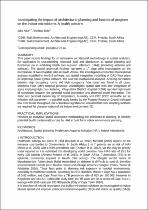 ResearchSpace
ResearchSpace
Investigating the impact of architectural planning and functional program on the indoor microbiome. A health concern
JavaScript is disabled for your browser. Some features of this site may not work without it.
- ResearchSpace
- →
- Research Publications/Outputs
- →
- Conference Publications
- →
- View Item
| dc.contributor.author |
Nice, Jako A

|
|
| dc.contributor.author |
Bole, Sheldon

|
|
| dc.date.accessioned | 2017-09-27T09:04:16Z | |
| dc.date.available | 2017-09-27T09:04:16Z | |
| dc.date.issued | 2016-07 | |
| dc.identifier.citation | Nice, J. and Bole, S. 2016. Investigating the impact of architectural planning and functional program on the indoor microbiome. A health concern. The 14th International Conference of Indoor Air Quality and Climate, 3-8 July 2016, Ghent, Belgium | en_US |
| dc.identifier.uri | http://www.isiaq.org/docs/Papers/Paper1121.pdf | |
| dc.identifier.uri | http://hdl.handle.net/10204/9602 | |
| dc.description | The 14th International Conference of Indoor Air Quality and Climate, 3-8 July 2016, Ghent, Belgium | en_US |
| dc.description.abstract | This paper reports findings for an innovative architectural methodology in spatial analytics, for application in characterising microbial load and distribution to spatial planning and functional use in inhibiting health care acquired infections (HAI); (including airborne and surfaces). The spatial analytical findings represent a 1st stage pilot investigation on the microbiome of two hospitals sites in South Africa. The investigation conducted observational analyses modelled in ArcGIS software, and spatial integration modelling of CAD floor plans in Depthmap Space Syntax software. The data was overlaid and analysed. A strong correlation between high occupancy rooms and high occupancy flow zones was found in all cases. Mitchells Plein (MP) hospital presented unintelligible spatial data with low integration of space implying high core clustering. Khayelitsha District Hospital (KDH) reported high levels of correlation between the potential social interaction and observed social interaction. The static and personal monitoring of temperature, humidity and CO2 (CO2 rebreathe air as infection risk parameter - a parallel study funded by the Fogarty Research Grant) indicated low CO2 levels throughout, but a statistical significance indicated that both sampling methods are required for characterisation of the indoor environment (IE). | en_US |
| dc.language.iso | en | en_US |
| dc.relation.ispartofseries | Worklist;18365 | |
| dc.subject | Indoor air quality | en_US |
| dc.subject | Indoor air climate | en_US |
| dc.subject | Architecture | en_US |
| dc.subject | Spatial planning | en_US |
| dc.subject | Healthcare Acquired Infection | en_US |
| dc.subject | HAI | en_US |
| dc.subject | Indoor microbiomes | en_US |
| dc.title | Investigating the impact of architectural planning and functional program on the indoor microbiome. A health concern | en_US |
| dc.type | Conference Presentation | en_US |
| dc.identifier.apacitation | Nice, J. A., & Bole, S. (2016). Investigating the impact of architectural planning and functional program on the indoor microbiome. A health concern. http://hdl.handle.net/10204/9602 | en_ZA |
| dc.identifier.chicagocitation | Nice, Jako A, and Sheldon Bole. "Investigating the impact of architectural planning and functional program on the indoor microbiome. A health concern." (2016): http://hdl.handle.net/10204/9602 | en_ZA |
| dc.identifier.vancouvercitation | Nice JA, Bole S, Investigating the impact of architectural planning and functional program on the indoor microbiome. A health concern; 2016. http://hdl.handle.net/10204/9602 . | en_ZA |
| dc.identifier.ris | TY - Conference Presentation AU - Nice, Jako A AU - Bole, Sheldon AB - This paper reports findings for an innovative architectural methodology in spatial analytics, for application in characterising microbial load and distribution to spatial planning and functional use in inhibiting health care acquired infections (HAI); (including airborne and surfaces). The spatial analytical findings represent a 1st stage pilot investigation on the microbiome of two hospitals sites in South Africa. The investigation conducted observational analyses modelled in ArcGIS software, and spatial integration modelling of CAD floor plans in Depthmap Space Syntax software. The data was overlaid and analysed. A strong correlation between high occupancy rooms and high occupancy flow zones was found in all cases. Mitchells Plein (MP) hospital presented unintelligible spatial data with low integration of space implying high core clustering. Khayelitsha District Hospital (KDH) reported high levels of correlation between the potential social interaction and observed social interaction. The static and personal monitoring of temperature, humidity and CO2 (CO2 rebreathe air as infection risk parameter - a parallel study funded by the Fogarty Research Grant) indicated low CO2 levels throughout, but a statistical significance indicated that both sampling methods are required for characterisation of the indoor environment (IE). DA - 2016-07 DB - ResearchSpace DP - CSIR KW - Indoor air quality KW - Indoor air climate KW - Architecture KW - Spatial planning KW - Healthcare Acquired Infection KW - HAI KW - Indoor microbiomes LK - https://researchspace.csir.co.za PY - 2016 T1 - Investigating the impact of architectural planning and functional program on the indoor microbiome. A health concern TI - Investigating the impact of architectural planning and functional program on the indoor microbiome. A health concern UR - http://hdl.handle.net/10204/9602 ER - | en_ZA |





